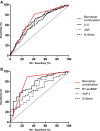Blood Biomarker Panels for the Early Prediction of Stroke-Associated Complications
- PMID: 33634708
- PMCID: PMC8174272
- DOI: 10.1161/JAHA.120.018946
Blood Biomarker Panels for the Early Prediction of Stroke-Associated Complications
Abstract
Background Acute decompensated heart failure (ADHF) and respiratory tract infections (RTIs) are potentially life-threatening complications in patients experiencing stroke during hospitalization. We aimed to test whether blood biomarker panels might predict these complications early after admission. Methods and Results Nine hundred thirty-eight patients experiencing ischemic stroke were prospectively recruited in the Stroke-Chip study. Post-stroke complications during hospitalization were retrospectively evaluated. Blood samples were drawn within 6 hours after stroke onset, and 14 biomarkers were analyzed by immunoassays. Biomarker values were normalized using log-transformation and Z score. PanelomiX algorithm was used to select panels with the best accuracy for predicting ADHF and RTI. Logistic regression models were constructed with the clinical variables and the biomarker panels. The additional predictive value of the panels compared with the clinical model alone was evaluated by receiver operating characteristic curves. An internal validation through a 10-fold cross-validation with 3 repeats was performed. ADHF and RTI occurred in 19 (2%) and 86 (9.1%) cases, respectively. Three-biomarker panels were developed as predictors: vascular adhesion protein-1 >5.67, NT-proBNP (N-terminal pro-B-type natriuretic peptide) >4.98 and d-dimer >5.38 (sensitivity, 89.5%; specificity, 71.7%) for ADHF; and interleukin-6 >3.97, von Willebrand factor >3.67, and d-dimer >4.58 (sensitivity, 82.6%; specificity, 59.8%) for RTI. Both panels independently predicted stroke complications (panel for ADHF: odds ratio [OR] [95% CI], 10.1 [3-52.2]; panel for RTI: OR, 3.73 [1.95-7.14]) after adjustment by clinical confounders. The addition of the panel to clinical predictors significantly improved areas under the curve of the receiver operating characteristic curves in both cases. Conclusions Blood biomarkers could be useful for the early prediction of ADHF and RTI. Future studies should assess the usefulness of these panels in front of patients experiencing stroke with respiratory symptoms such as dyspnea.
Keywords: ADHF; biomarkers; stroke; stroke‐associated infection.
Conflict of interest statement
None.
Figures


Similar articles
-
Blood Biomarkers for the Early Diagnosis of Stroke: The Stroke-Chip Study.Stroke. 2017 Sep;48(9):2419-2425. doi: 10.1161/STROKEAHA.117.017076. Epub 2017 Jul 17. Stroke. 2017. PMID: 28716979
-
Urine N-terminal pro-B-type natriuretic peptide and plasma proenkephalin are promising biomarkers for early diagnosis of cardiorenal syndrome type 1 in acute decompensated heart failure: a prospective, double-center, observational study in real-world.Ren Fail. 2022 Dec;44(1):1486-1497. doi: 10.1080/0886022X.2022.2114367. Ren Fail. 2022. PMID: 36000917 Free PMC article.
-
Clinical utility of N-terminal pro-B-type natriuretic peptide for risk stratification of patients with acute decompensated heart failure. Derivation and validation of the ADHF/NT-proBNP risk score.Int J Cardiol. 2013 Oct 3;168(3):2120-6. doi: 10.1016/j.ijcard.2013.01.005. Epub 2013 Feb 6. Int J Cardiol. 2013. PMID: 23395457
-
The predictive value of plasma biomarkers in discharged heart failure patients: role of plasma NT-proBNP.Minerva Cardioangiol. 2016 Apr;64(2):157-64. Epub 2015 Sep 15. Minerva Cardioangiol. 2016. PMID: 26373781 Review.
-
N-Terminal B-type Natriuretic Peptide in Heart Failure.Heart Fail Clin. 2018 Jan;14(1):27-39. doi: 10.1016/j.hfc.2017.08.004. Heart Fail Clin. 2018. PMID: 29153198 Review.
Cited by
-
Circulating Inflammatory Biomarkers in Early Prediction of Stroke-Associated Infections.Int J Mol Sci. 2022 Nov 9;23(22):13747. doi: 10.3390/ijms232213747. Int J Mol Sci. 2022. PMID: 36430226 Free PMC article.
-
Heart Disease and Stroke Statistics-2023 Update: A Report From the American Heart Association.Circulation. 2023 Feb 21;147(8):e93-e621. doi: 10.1161/CIR.0000000000001123. Epub 2023 Jan 25. Circulation. 2023. PMID: 36695182 Free PMC article. Review.
-
Predictive Value of NT-proBNP for Functional Outcome of Ischemic Stroke Without Cardiac Disease: A Prospective, Observational Study.Neuropsychiatr Dis Treat. 2025 Jan 27;21:129-140. doi: 10.2147/NDT.S488574. eCollection 2025. Neuropsychiatr Dis Treat. 2025. PMID: 39897711 Free PMC article. Clinical Trial.
-
Novel Predictors of Stroke-Associated Pneumonia: A Single Center Analysis.Front Neurol. 2022 Mar 30;13:857420. doi: 10.3389/fneur.2022.857420. eCollection 2022. Front Neurol. 2022. PMID: 35432153 Free PMC article.
-
The Role of Complete Blood Count-Derived Inflammatory Biomarkers as Predictors of Infection After Acute Ischemic Stroke: A Single-Center Retrospective Study.Medicina (Kaunas). 2024 Dec 18;60(12):2076. doi: 10.3390/medicina60122076. Medicina (Kaunas). 2024. PMID: 39768955 Free PMC article.
References
Publication types
MeSH terms
Substances
LinkOut - more resources
Full Text Sources
Other Literature Sources
Medical
Research Materials

